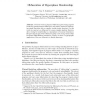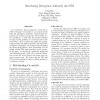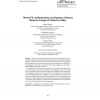284 search results - page 26 / 57 » Securing digital signatures for non-repudiation |
TCC
2010
Springer
13 years 6 months ago
2010
Springer
Previous work on program obfuscation gives strong negative results for general-purpose obfuscators, and positive results for obfuscating simple functions such as equality testing (...
ACSAC
2000
IEEE
14 years 9 days ago
2000
IEEE
It is well-known that CA plays the central role in PKI. In this paper we introduce a new component into PKI, DA (decryption authority), which decrypts important and sensitive mess...
ACISP
2007
Springer
14 years 2 months ago
2007
Springer
Abstract. Digital signatures are often proven to be secure in the random oracle model while hash functions deviate more and more from this idealization. Liskov proposed to model a ...
JOC
2006
13 years 7 months ago
2006
Abstract. In response to the current need for fast, secure and cheap public-key cryptography, we propose an interactive zero-knowledge identification scheme and a derived signature...
ACNS
2003
Springer
14 years 1 months ago
2003
Springer
Key exposures, known or inconspicuous, are a real security threat. Recovery mechanisms from such exposures are required. For digital signatures such a recovery should ideally —an...



